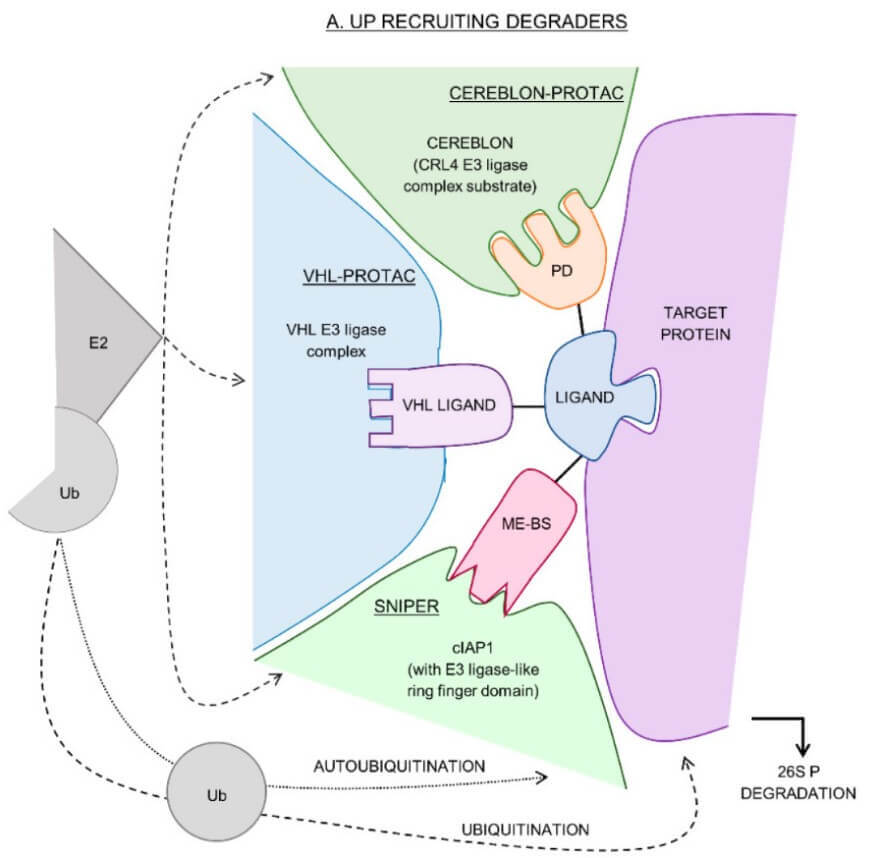Among the natural protein degradation cascades, the ubiquitin-proteasome (UP) cascade is most characteristic. The enzymes E1, E2, and E3 ligases mediate the labeling of the target protein with ubiquitin, thereby allowing the capped (26S) proteasome to recognize and degrade it. Two types of degradation agents that researchers have used for this cascade are protein-targeted chimeric molecules (Protacs) and specific and non-genetic IAP-dependent protein erasure agents (SNIPER). Both of these molecules consist of a protein-binding ligand, a linker, and an E3 ligase-binding ligand, allowing the recruited E3 ligase to bind and subsequently degrade the target protein. Protacs usually recruit the cerebellum (culin loop E3 ligase 4 complex substrate receptor CLR4) and von Hippel-Lindau (VHL) E3 ligase complex, while SNIPERs recruit the anti-apoptotic protein cIAP1.

SNIPER can be used to develop small-molecule drugs that promote protein degradation and can directly fuse the ligand of the target protein with the E3 ligase ligand. One example is a hybrid based on the cIAP1 ligand MeBS and the retinoic acid receptor ligand all-trans retinoic acid (ATRA). It can guide cIAP1 ubiquitination and degradation of intracellular retinoic acid-binding proteins, which play important roles in acute promyelocytic leukemia and neuroblastoma. Similarly, using SNIPER technology, tamoxifen targeting ERα in breast cancer has also achieved good results in vitro.
SNIPER aims to induce IAP-mediated ubiquitination and proteasome degradation of target proteins. By combining various inhibitors (such as ABL, BRD, AR, ER) and IAP ligands, a series of SNIPER (ABL) compounds were synthesized, and the protein knockout activity of the linker was optimized. Estrogen receptor (ER)α + accounts for 80% of all newly diagnosed cases of breast cancer. Current therapies targeting the ER signaling pathway include antagonizing and/or down-regulating ER or reducing estrogen levels. Researchers used SNIPER (ER) -3 linked to 4-hydroxy tamoxifen and MeBS, which targets ubiquitination labeling ERα via EIA ubiquitin ligase containing cIAP1 and effectively induces ERα degradation. While no effect on other ER-negative cells, this blocked the expression of the estradiol downstream gene PS2, strongly induced the production of ROS, and eventually led to the apoptosis of the ER-positive cell line MCF-7.
References:
- Shibata, N. , Nagai, K. , Morita, Y. , Ujikawa, O. , Ohoka, N. , & Hattori, T. , et al. (2017). Development of protein degradation inducers of androgen receptor by conjugation of androgen receptor ligands and inhibitor of apoptosis protein (iap) ligands. Journal of Medicinal Chemistry, acs.jmedchem.7b00168.
- https://doi.org/10.3390/molecules24183272





















